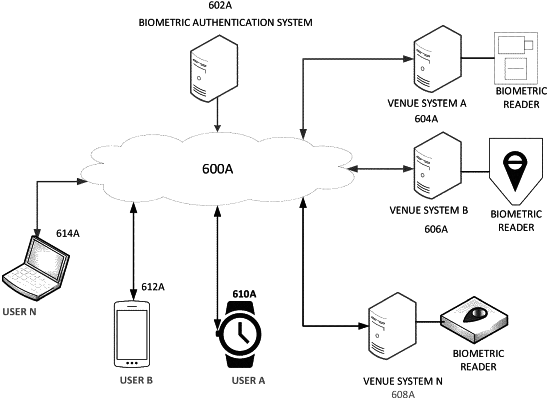| CPC G06F 21/32 (2013.01) [G06V 40/117 (2022.01); G06V 40/169 (2022.01); G06V 40/18 (2022.01); G06F 2221/2141 (2013.01)] | 24 Claims |

|
1. A computer-implemented method of electronically authenticating a person using biometrics, the method comprising:
storing in memory an indication as to what types of biometric readers are used at a first plurality of different locations, the first plurality of different locations comprising event venues configured to host in-person events;
receiving, at a first time, comprising a first date, a first biometric reading of a first type of a first person from a first biometric reader of a first type at a first location;
at least partly in response to a match being identified of the first biometric reading of the first type of the first person from the first biometric reader of the first type at the first location with a given biometric identifier of the first type stored in a datastore comprising biometric identifiers, retrieve event access data associated with the given biometric identifier of the first type;
determining whether the event access data associated with the given biometric identifier of the first type grants the first person access to the first location for a first in-person event occurring at the first location;
at least partly in response to determining that the event access data associated with the given biometric identifier of the first type grants the first person access to the first location for the first event occurring at the first location, transmitting a command causing an access granted indicator to be presented by a first device to thereby enable the first person to access the first location for the first in-person event occurring at the first location;
receiving, at a second time, comprising a second date, a second biometric reading of the first person from a second biometric reader at a second location, the second biometric reader of a different type than the first biometric reader;
based at least in part on the second location, determining that the second biometric reading is of a second type, the second type different than the first biometric reading of the first type;
at least partly in response to determining that the second biometric reading is of a second type based at least in part on the second location, comparing the second biometric reading of the second type of the first person from the second biometric reader of the second type at the second location with biometric identifiers of the second type stored in the datastore comprising biometric identifiers;
at least partly in response to identifying a match of the second biometric reading of the second type of the first person from the second biometric reader of the second type at the second location with a given biometric identifier of the second type stored in the datastore comprising biometric identifiers, retrieve event access data, associated with the given biometric identifier of the second type;
determining whether the event access data associated with the given biometric identifier of the second type grants the first person access to the second location for a second in-person event; and
at least partly in response to determining that the event access data associated with the given biometric identifier of the second type grants the first person access to the second location the second in-person event, transmitting a command causing an access granted indicator to be presented by a second device.
|